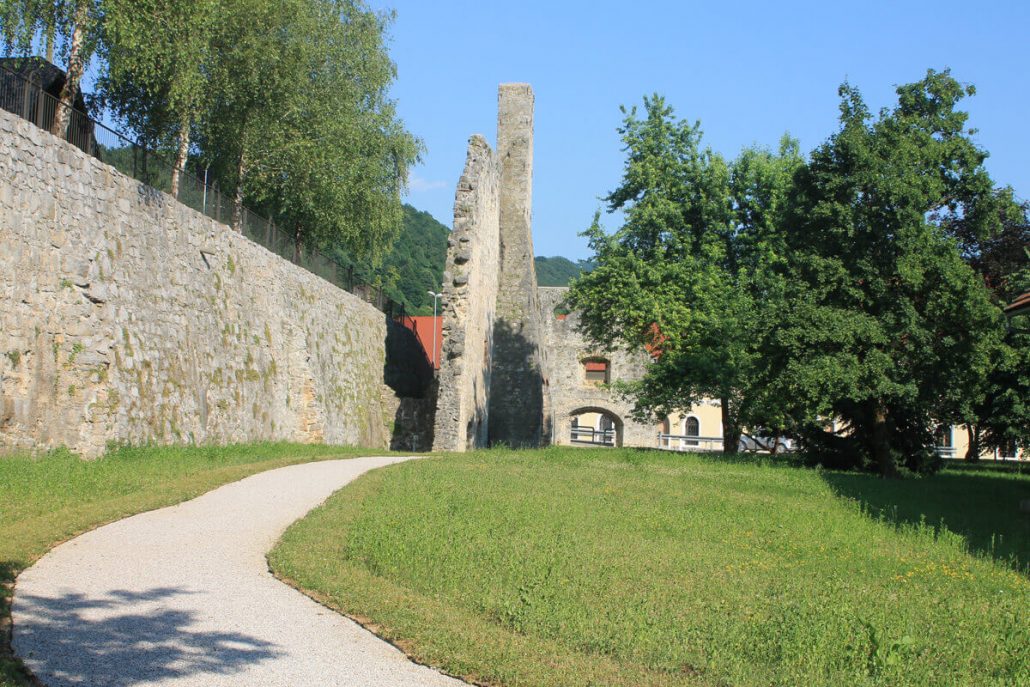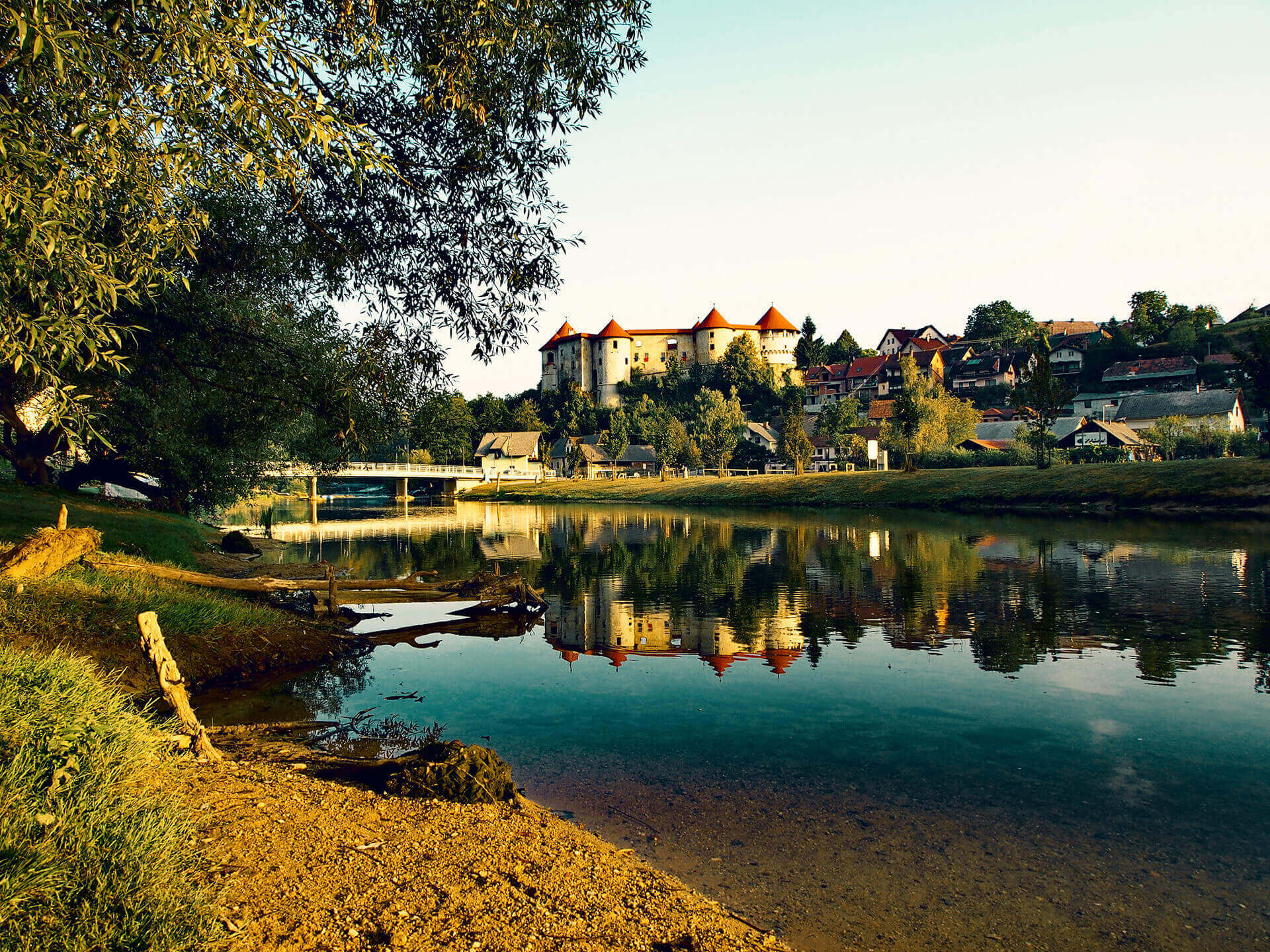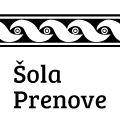A walk with great personalities
The Krka River, which creates many tufa barriers here, accompanies you along the way. Traces of a great iron-foundry past wait to be discovered. Hospitable people invite you to meet them.
Welcome among the people of Suha krajina
Start getting to know the special features and important people of Suha krajina (1) at the square in the very centre of Žužemberk. Visit the Memorial park (2) with bronze reliefs and inscriptions of names of personalities, associated with this interesting part of Dolenjska. At least two of them, the knight Andrej Turjaški (1557)-1594), the winner of the epic battle against the Turks at Sisak, and Prince Janez Vajkard Turjaški (1615-1677), invite you to Žužemberk Castle (3), the biggest attraction of the town. A typical medieval fortress with picturesque towers stands on a rock above the Krka River (4). Get to know the interesting backdrop of great stories and return to the castle in time of the biggest Žužemberk events, such as the Market Days in July.
Interesting objects from the past
From the castle, head to Žužemberk Primary School. On your way, the balcony of the fire station greets you with a restored fire pump of Požarna bramba Žužemberške (5) from 1888. In front of the school is a bust of Leon Štukelj, a Slovenian Olympian who often visited his grandparents in a village near Žužemberk. By prior arrangement with the school, you can visit the Museum of the famous people of Suha Krajina (6) with interesting pieces. Most of them were donated to the school by the relatives of people who spread the word about Suha krajina all over the world.
Film moments of cosmopolitanism
Continue along the Breg, which is the birthplace of Zalla Zarana (7) – the first Slovenian film actress in Hollywood. She began to realize her American dream as early as 1921. From here, walk to the bridge across the Krka and enjoy the beautiful cinematic views. You can also admire the tufa rapids (8), which cause countless small waterfalls. The murmur of the Krka directs you to the house of Vinko Globokar (8), the world-renowned trombonist, composer and professor.
Sacral and technical heritage
Your next stop is – a Storm at Sea. This is the name of the fresco that adorns the facade of the Church of St. Nicholas (9) or. St. Miklavž, as the locals call the church. A Roman tombstone is also built onto it. Žužemberk’s oldest church was built in the 13th century. From there, take the steps to the street just above the church, which offers beautiful views of the castle, the river and Žužemberk. At the end of the steep street stop at the cast iron pumping station, built by the former Ausersperg iron works ( 10 ) in nearby Dvor.
Return over the wooden bridge
On the way to the end of Trške njive street, observe the beauty of the landscape, then turn right and take the road back to the Krka. You will find Tomaž’s bridge of love (11). The new wooden bridge stands on the site of the previous one, which connected the riverbanks with two mills. Cross the bridge and return to the starting point of your wandering – to the centre of Žužemberk.
A Tip: Gather your impressions from a walk around Žužemberk at lunch or have some refreshments in the Gostilna pri gradu inn on the central square, where they offer typical Slovenian dishes. On Grajski trg square, there is also Gobja hiška pizzeria with a beautiful view of the river. By the Krka, near St. Nicholas’s Church, is Gostinstvo Koren inn.
Namig: Vtise s potepa po Žužemberku strnite ob obedu ali okrepčilu v Gostilni pri gradu na osrednjem trgu, kjer ponujajo značilne slovenske jedi. Na Grajskem trgu je tudi picerija Gobja hiška z lepim pogledom na reko Krko. Ob reki Krki, pa v bližini sv. Nikolaja, pa Gostinstvo Koren.
Suggestions for a hike
Along the Roman road to the iron works mansion
From the centre of Žužemberk, take the 2-hour circular route to Auersperg’s iron foundry at Dvor. From Žužemberk castle head toward the lookout parish church of St. Mohor and Fortunatus, where the route of the former Roman road and later the imperial trade route begins. This interesting, meandering road was in use until 1859, when a new road was built along the Krka valley. On the way, you will find the stonecutter and foundry monument Naralov pil in Trebča vas, Auersperg’s Iron-foundry and the Ironworks Museum and Gallery in Dvor, the ruins of a former sawmill, a power plant and two mills in Jama as well as several churches. The road will take you past hospitable homesteads. You can choose and see the sights along the Krka River, where you can go swimming, paddling, boating or fishing.
More information: Suha krajina Tourist Association; phone: 041 324 710 or 041 539 292

1. Suha krajina
Žužemberk is the centre of Suha krajina, a karst region in the northwest of Dolenjska. The name of the landscape is associated with permeable soil and limestone base. Most of the water here sinks into the groundwater, leaving little on the surface. Suha krajina with the upper reaches of the Krka River is surrounded by the Korinjska and Ajdovska plateaus.
2. Memorial Park of famous people from Suha krajina
Four monuments, fifteen bronze reliefs and nine granite pillars represent 40 famous people from Suha krajina. Among them are priests, professors, writers, politicians, painters, a knight and a prince, an admiral, a pilot, a film actress … In addition to other important personalities, the bronze reliefs also depict the world-famous alpinist Tomaž Humar and the Olympic winner Leon Štukelj.
Grajski trg 33
3. Žužemberk castle
The year 1000 was once carved in the entrance portal of the castle. According to this, William I, the husband of St. Emma, is said to have built the first fortress on this site. The first written mention of the castle dates back to 1295, when it was bought by the counts of Gorizia. In the 14th century, the castle passed into the hands of the Counts of Cilli, and a century later it was owned by the Habsburgs. Emperor Ferdinand sold it to the Auersperg family in the 16th century. The castle was given defensive towers and a mighty bastion. The Auerspergs owned the castle until World War II. In 1943, the castle was burnt in the battles and the town of Žužemberk was bombed in 1945. Gradual restoration of the castle began after 1960.
Grajski trg 1
4. Krka river
Krka, ki svojo pot po površju začenja v kraškem izviru v zahodni Suhi krajini, v svojem zgornjem toku teče po ozki dolini, nastali vzdolž žužemberškega preloma. Na poti se reka neopazno povečuje, saj vanjo pritekajo vode iz kraškega podzemlja. Krka je največja dolenjska reka in druga najdaljša reka, ki teče samo po ozemlju Slovenije. Od izvira do izliva v redko Savo preteče okoli 100 kilometrov. Na območju Žužemberka je na reki naravno kopalno območje, primerno za plavanje. Reka privlači tudi ribiče in ljubitelje čolnarjenja.
5. Požarna bramba (Žužemberk firefighting society)
The Society, founded in 1888, built a storage facility and bought smaller firefighting equipment and the fire pump in the first year of its operations with strong support from the notable townspeople. That same year, the fire brigade successfully contained a fire in one of the market houses. The establishment of the brigade impressed the emigrants as well, who sent a banner to the society in their native Žužemberk in 1891. The first more powerful fire pump was bought in 1895 with help of financial donations. It was used to defend almost every village in Suha krajina against major fires.
PGD Žužemberk, Grajski trg 42
6. Museum of famous people from Suha krajina
The lobby and the staircase boast museum showcases filled with manuscripts, documents, objects, books, and photographs of famous Suha Krajina people. The pupils of the school prepared a research assignment about each of them. Among the most precious items is a magnifying glass with a silver handle, which was donated to the Olympian Leon Štukelj by the Mayor of New York. A school project, which started in 2001, was the predecessor of the Memorial Park of Famous People from Suha krajina.
Žužemberk Elementary School, Baragova cesta 1, T: 07 308 70 22
7. Zalla Zarana’s birth house
Zalla Zarana is the stage name of Rozalija Sršen (1897 – 1967), born in Žužemberk. The family soon moved to Vipava and then to Ljubljana. Teenager Rosalija went to an evening school and learnt English, bookkeeping, typing and other trade subjects. At 17, she set out on a trip to America, to Los Angeles. As early as 1921, she landed her first major role in a Hollywood film. She appeared in 20 silent films, but performed also in theatre. A memorial plaque has been erected in honour of the actress on the facade of her birth house.
Breg 21
8. Tufa barriers on the Krka river
The Krka River is the only major Slovenian river that deposits tufa or “light stone”. It is formed by the deposition of calcium carbonate on mosses and other aquatic plants. The characteristically perforated and light stone forms tufa barriers. They are most numerous and most beautiful in the upper reaches of the Krka, between Zagradec and Žužemberk. Numerous mills and sawmills once operated there.
9. House of Vinko Globokar
Vinko Globokar, a trombonist living in France, composer, conductor, professor at renowned music academies and author of several publications on music, likes to return to Suha Krajina, where his parents come from. He is considered an important researcher of sounds. In 2002, he received the Prešeren Lifetime Achievement Award and is the first honorary citizen of the Municipality of Žužemberk.
Nad Miklavžem 8
10. St. Nicholas’s church
The beginnings of the oldest preserved church in Žužemberk date back to the 13th century, and the interior of the church underwent major alterations in the 17th century. The church has preserved frescoes from the middle of the 15th century. The fresco of Adam and Eve is attributed to Janez Ljubljanski (Johannes of Ljubljana), a famous painter of the time.
Nad Miklavžem 5
11. Ausersperg’s iron foundry
Auersperg’s ironworks in Dvor was one of the most important industrial plants in Dolenjska. Its owners were the Auerspergs. The permission to erect the blast furnace and foundry was obtained in 1763, and production began in 1796. In the 19th century, the ironworks switched to iron foundry. They made machines, ammunition, bridges, water pipes, wells, stoves, building elements, tombstones, and useful and decorative items for home use. In the Ironworks Museum you can see a collection of original castings, the history of foundry at Dvor and demonstrations of smelting, mould making and casting.
Ironworks Museum and Gallery, Dvor 46, T: 041 234 744
12. Tomaž 's bridge of love
Until 2010, a bridge built in the 19th century and rebuilt after the Second World War connected the banks of the Krka River, along which mills once operated. The wooden bridge was only partially passable after the floods. In 2014, a brand new one, a 53-metre-long bridge, which has concrete foundations and wooden pillars, replaced it.
And why is it called the bridge of love? Frančišek Novak also called Vaupetov France, who passed away in 2021, explained that the children of Žužemberk learned about love by the bridge and on the bridge, as they kissed and …
Trške njive 44
Železo-livarski muzej in galerija, Dvor 46, T: 041 234 744
- 11. Suha krajina
- 22. Memorial Park of famous people from Suha krajina
- 33. Žužemberk castle
- 44. Krka river
- 55. Požarna bramba (Žužemberk firefighting society)
- 66. Museum of famous people from Suha krajina
- 77. Zalla Zarana’s birth house
- 88. Tufa barriers on the Krka river
- 99. House of Vinko Globokar
- 1010. St. Nicholas’s church
- 1111. Ausersperg’s iron foundry
- 1212. Tomaž 's bridge of love





